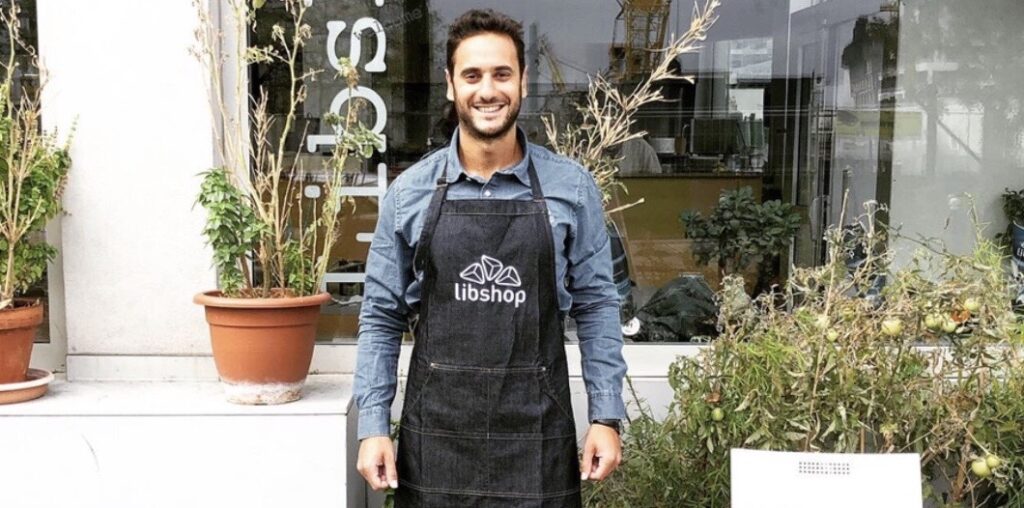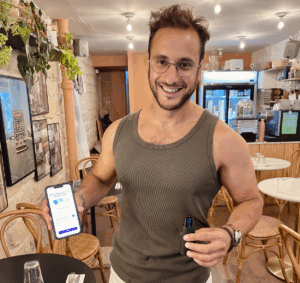Hello and welcome to this sub-part of the chapter “Health Master Plan”, taken from introductory guide to foodtech and the basics of modern catering 🙂
Today, we will focus on the part " The staff " of the Good Hygiene Practices (GHP). You will list everything I will tell you below and adapt it to your needs, in your own document.
Hygiene of premises
Locker rooms
Locker rooms are where your employees go to change and store their belongings. First of all, we should ensure that there is as many lockers as employees, and that the surface area of the changing rooms is sufficient in terms of surface area and height so that they can change.
A word of advice: schedule your teams one by one or two by two with a slight delay at the start of work so that everyone can change in peace.
For the purchase of lockers, I recommend CIMM who are very reactive, or even Equipment Area, from whom I ordered mine and with whom I am very satisfied!
Toilet
Staff must be provided with toilets of their own, and which are otherwise clean 🙂
Equipped with English-style bowls, the toilets must be cleaned at least once a day, and the trash cans must be able to open without contact with hands.
The hand wash
The hand basin must be equipped with a non-manual control and easily accessible by staff. It must be supplied with hot and cold water, and must have bactericidal soap, nail brushes (ideally one of each color for each employee working in the kitchen) and disposable hand towels.
The nail brush must be properly maintained and kept dry, in a dry place, so as not to become a breeding ground for bacteria.
Hand wiping should be done with a single-use system in good working order.
Finally, hand washing devices must be in sufficient number, judiciously placed (at the exit of the toilet, at the entrance to the kitchen, etc.), correctly maintained and stocked (filled dispensers, etc.). A trash bin must be provided to throw away used papers.
If you are not a handyman, and you wish to delegate the entire part of bringing your toilets and hand basins up to standard, I advise you to work with Thanks Jack, a start-up specializing in the maintenance of professional premises, which I tested here:
https://tulipeo-tulipemedia.pf28.wpserveur.net/merci-jack-test-avis/
What I advise you is, on the one hand:
- to list all these upgrades in a document which will be part of your Health Control Plan, in the event of an inspection, and in order to have clear ideas, especially if you manage several premises;
- then set up all these hygiene measures related to personnel, having as “to-do” your famous document.
Clothing hygiene
I invite you to formalize in the remainder of your “Good Hygiene Practices” document the ideal outfit for each of the workstations you need for your activity.
First of all, staff must have a changing room (cupboard or room) allowing them to:
- put on your work clothes;
- drop off your street clothes and personal effects.
Street clothes and work clothes must be stored in separate spaces, just as dirty laundry and clean laundry must not be mixed.
So, when it comes to cooks for example, you should list the following accessories:
- A cap or charlotte (long hair always tied up).
- A kitchen uniform not to be mixed with personal belongings, hence the individual double-capacity lockers, with pants, jacket, and clean and maintained safety shoes. Possibly an apron, to be renewed at each service.
- If possible a jacket that is fire or cold resistant, depending on the position.
- Possibly masks (no need for FFP standard).
Work clothing must be changed at least every two days and more if necessary. Maintenance of the outfits can be carried out by the employee for compensation on the pay slip, or by a specialized company which supplies and cleans the outfits.
Once you have formalized all of this, take action, by ordering all these accessories and making them available to your employees.
Hand hygiene
As I explained to you in the Cleaning and Disinfection Plan, hand hygiene is extremely important, whether for cooks handling food, or even waiters or multi-tasking team members in close contact with food.
Here are the basic rules, to be recorded in your document, which you will communicate to your teams, which you will enforce and whose correct implementation you will monitor as an operator:
- Jewelry must be removed;
- No handling of food in case of wound, dry hands or dermatological problem;
- No nail polish;
- No long nails, unless you are Jimmy Hendrix and in which case, I advise you to start an artistic career at 100%;
The case of gloves
In an exceptional case where it would be impossible to follow the instructions above, particularly in the case of a varnish already done or a wound, put imperatively gloves changed often.
In the case of wearing gloves, they must be changed each time they change positions or handle another tool, each time they leave the kitchen, each time they are soiled by something else, and must not be used for consult your smartphone or other tablet.
Wearing wire mesh gloves can be useful for positions where there is a lot of cutting to be done.
It is also necessary to plan gloves exclusively reserved for household use, and possibly thermal protection gloves if the position requires them (handling hot and cold).
Hand washing
Here are the guidelines to integrate into your documentation and communicate to your teams.
Hand cleaning must be done, at least :
- when taking or returning to work,
- after going to the toilet,
- after blowing your nose, coughing, touching your nose, hair or head,
- after a contaminating operation (handling trash, packaging and shell eggs, peeling vegetables, etc.),
- before sensitive operations (chopping, etc.) or before handling sensitive products
(mayonnaise, tartar, carpaccio, etc.). - After each cleaning operation
Here are the essential steps when cleaning your hands:
- Humidify
- Soap
- Rub for at least 30 seconds
- Brush your nails
- Rinse
- Then dry well with a single-use paper
Warning: hydroalcoholic gel does not replace hand washing! It is there to eliminate bacteria and viruses, but it does not clean dirt. See the Cleaning and Disinfection Plan chapter, where I explain the difference between cleaning and disinfecting 😉

All this information related to hand hygiene that I have just made available to you must be reproduced as is or adapted according to your needs, in your document of BPH which will be part of your PMS. Reread them several times, and communicate them to your teams by displaying them in the technical sections, and sending them in digital format.
Outside people
People outside the company (maintenance, delivery, etc.) are likely to circulate in the
local. To this end, specific provisions must be made to avoid any risk of contamination of the working environment and products:
- provision of protective clothing
- circulation circuit
- intervention times (intervention outside manufacturing hours for example or services).
Furthermore, it will be necessary to indicate in your documentation that staff who are not part of the kitchen must not enter except in emergencies or special cases, taking the usual precautions. Thus, delivery men returning from a delivery do not have to go into the kitchen to chat with the food preparers, for example.
Appropriate behavior during work
Personnel handling foodstuffs must behave in a way that limits the risks of
contamination of these.
- It is therefore forbidden to drink, eat (apart from tastings) and smoke in the manufacturing premises.
- It is also advisable to substitute, whenever the situation allows, clean utensils (tweezers, spoons, etc.) for use with the hands.
- Likewise, you should not taste the preparations with your finger but use, for this purpose, a clean utensil, which must not be reused!
- Finally, any contact of the face (eyes, hands, nose, etc.) with the hands or forearms must be limited as much as possible, so as not to contaminate food.
Hygiene monitoring
Monitoring staff hygiene must result in particular in:
- a visual check of staff personal hygiene,
- a visual check of the wearing of the complete outfit as well as its cleanliness,
- appropriate medical supervision (we will come to this shortly).
Medical provisions
here are some obligations to respect, as an operator. I recommend that you resume the entire theory part as is in your document as a memo, and you can add practical sheets which you will remember to fill out.
Occupational medicine
Upon hiring, the employee benefits from a medical exam, by occupational medicine, at the latest during the three months following hiring. This visit is now formally called the Information and Prevention Visit (VIP). The doctor delivers a suitability opinion at the end of this visit.
This will be what we call a simple individual monitoring (SIS), which will be characterized by a medical examination every five years, unless the position occupied is at risk.
It is sometimes necessary to carry out a adapted individual monitoring (SIA). If the employee is a minor, works night shift, is disabled, receives a disability pension, is pregnant, breastfeeding or has just given birth. In the case of an SIA, the interval between two medical visits cannot exceed 3 years.
Finally, a collaborator will have to undergo a medical examination in the following three cases:
- After a work stoppage of more than 3 months
- After maternity leave
- After an absence of at least 30 days due to a work accident or illness
or non-professional accident.
The visit should ideally take place on the day of the employee's effective return or at the latest within
a period of 8 days following this recovery.
Finally, there is reinforced individual monitoring, for really very specific cases (asbestos, biological risks, etc.), which we will not discuss here.
Since the state of health of a member of the kitchen staff may present a risk
for the consumer, a medical examination must be carried out.
You should also be aware that anyone working within your organization who knows they have a food-borne illness is not permitted to work in a food handling area because they have a risk for the consumer. This person must undergo a medical examination, and kitchen staff must notify their supervisor in such cases.
Where to find your occupational health organization?
You can search the internet to find an organization relatively close to your premises. Otherwise, I suggest you consult this directory of Interservice health and occupational medicine center.
Important: the staff medical monitoring sheet
You must attach to your PMS a medical monitoring sheet for your employees. It will be a sort of historical record opinions on the suitability or incapacity of your employees, with the duration of absence in the event of sick leave if applicable.
Given that there is one sheet per employee, I highly suggest that you digitize this part, in an excel table that you will update over time. Record all of this on the cloud, so you don't have to lose it if your hard drive ever fails.
Here is an example of Excel sheet that you can use to make the follow-up of these medical checks, do not hesitate to take the model and adapt it to your needs!
In this sheet which will require Microsoft Excel, I have created formulas which allow you to indicate, depending on the date of the last medical visit, and depending on the fact that the employee is in simple follow-up (every 5 years) or adapted (every 3 years), whether or not the employee must be summoned for a medical check-up, as well as the date of the next medical check-up. Everything is automatic, take advantage of it!
[icon_link style= »download » color= »yellow » href= »https://tulipeo-tulipemedia.pf28.wpserveur.net/wp-content/uploads/2020/04/Suivi-de-control-médical-1.xlsx » target= »_blank »]Download the medical check-up follow-up[/icon_link]
The medicine cabinet
As an operator, you must provide your staff with a cabinet or large first aid kit containing at least:
- Compress
- Antiseptic (this is the equivalent of disinfectant, but for living tissues)
- Band-aid
- Compression dressings
- Adhesives, Hemostats
- Single-use finger cots
- Cream for light burns
- Oral-nasal mask
- Eyewash or equivalent system
- Bruise cream
- Disposable gloves
- Scissors
The rest will be defined with occupational medicine, but if you already have all this for a restaurant, that's great! However, it will be necessary to carry out regular checks, once a month, of deadlines and stock levels.
Make this list in your BPH document, and make sure you have what you need!
Health status display
Any person whose state of health (vomiting, diarrhea, infected wound, rhinitis, etc.) could lead to contamination of products and/or the work environment must report this. Appropriate measures must be taken.
This is why I invite you to display the following display in your restaurant, in addition to the previous sentence:
- In case of nasopharyngeal symptoms (cold, cough, bronchitis, sore throat) : obligation to wear a mask available in the first aid kit, and to report your state of health to your superiors.
- Cuts, wounds : obligation to clean and disinfect (antiseptic in the first aid kit) then protect the wound by a waterproof dressing renewed regularly and mandatory wearing of gloves, or even finger cot.
- In case of gastrointestinal disorders, infected wounds, abscesses : report to the hierarchy, obligatory stop.
To make things easier for you, I created a beautiful PDF in A4 format that you can display in technical parts, and that you can also insert into your technical documentation. You can download it by clicking on the image below!
[icon_link style= »download » color= »yellow » href= »https://tulipeo-tulipemedia.pf28.wpserveur.net/wp-content/uploads/2020/04/BPH-_-Etat-de-santé_tulipemedia.pdf » target= »_blank »]Download health status display[/icon_link]
Training obligation
Any structure manager handling foodstuffs is required to regularly train its staff in hygiene and food safety and appoint a HACCP method representative for its application.
In practice, at least one person working in the establishment – ideally the manager – must be trained in food hygiene, and this training lasts 14 hours. If the operator is already qualified, there is no obligation to train his manager or any other member of the team, but I strongly recommend that you do so, at least for the manager, then why not other members.
At the end of the training, you will receive a diploma which authorizes you to operate the establishment. I suggest you digitize this diploma, and attach all the diplomas received by yourself, your managers and more generally your person, to your famous personnel document, which will be part of your Health Control Plan. Keep all this data safe.
Then, when a new employee arrives, training in good hygiene practices
and cooking must be provided by the manager or a training consultant. A personal training certificate will be provided, and a copy of the training certificates must be kept on site.
In practice, here is how the “dilution” of information occurs across your organization (leave these notes in the final document):
- Organization of regular hygiene training, by recognized organizations. I refer you to Christophe ROGER, my hygiene trainer, expert in collective catering for 20 years.
- A delivery of educational documentation, taken from your PMS, with explanatory meetings in the presence of the staff, by the trained and qualified HACCP reference person.
- Regular specific practical training (cooking, sandwich preparation, etc.).
- A delivery to all staff of this BPH guide, as well as that of HACCP.
- And the usual displays already listed here and elsewhere in the PMS.
- Training upon the arrival of a new employee, with a personal training certificate.
And that's it, the game is over “Staff hygiene” of yours BPH ! Now we attack the sacrosanct Cleaning and Disinfection Plan, which constitutes an absolutely CENTRAL chapter of your GHP and your PMS.
Find the summary of the PMS by following this link!
If this tutorial helped you, you can thank me by sharing it on social networks and notifying me, it will make me very happy!!!







